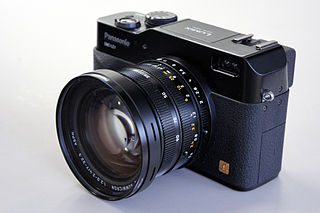
Lumix is Panasonic's brand of digital cameras, ranging from pocket point-and-shoot models to digital SLRs.

The Micro Four Thirds system is a standard released by Olympus and Panasonic in 2008, for the design and development of mirrorless interchangeable lens digital cameras, camcorders and lenses. Camera bodies are available from Blackmagic, DJI, JVC, Kodak, Olympus, Panasonic, Sharp, and Xiaomi. MFT lenses are produced by Cosina Voigtländer, DJI, Kowa, Kodak, Mitakon, Olympus, Panasonic, Samyang, Sharp, Sigma, SLR Magic, Tamron, Tokina, TTArtisan, Veydra, Xiaomi, Laowa, Yongnuo, Zonlai, Lensbaby, Venus Optics and 7artisans amongst others.

The Panasonic Lumix DMC-G1 was the first digital mirrorless interchangeable-lens camera (MILC) adhering to the Micro Four Thirds system design standard. The G1 camera is similar to the larger Four Thirds system format DSLR cameras, but replaces the complex optical path needed for the optical viewfinder with an electronic viewfinder EVF displaying a live view image directly from the sensor. Eliminating the mirror box and optical viewfinder allows for smaller and lighter camera bodies, while the less complex optical path also allows for smaller, lighter lens designs.

The Panasonic Lumix DMC-FZ28 is a superzoom bridge digital camera, replacing the similar Panasonic Lumix DMC-FZ18. It was announced in 2008 and released for sale in the United Kingdom in August of that year. Like the FZ18 it has a Leica lens with an 18x optical zoom ratio. It has a slightly larger sensor than the FZ18, a 10.1-megapixel image resolution, and the newer Venus IV image processing engine.

The Panasonic Lumix DMC-GH1 is a digital mirrorless interchangeable lens camera adhering to the Olympus and Panasonic developed Micro Four Thirds System (MFT) system design standard. Panasonic classified the GH1 as a hybrid stills/video camera and the GH1 was introduced and marketed as a higher end camera than Panasonic's first MFT camera, the stills only, non-video capable Lumix DMC-G1.

The Panasonic Lumix DMC-GH2 is a digital camera with HD video recording capability that is part of the Micro Four Thirds system. Though commonly referred to as a DSLR camera, it has no mirror or optical viewfinder, but has instead both a fold-out LCD screen and a electronic viewfinder.
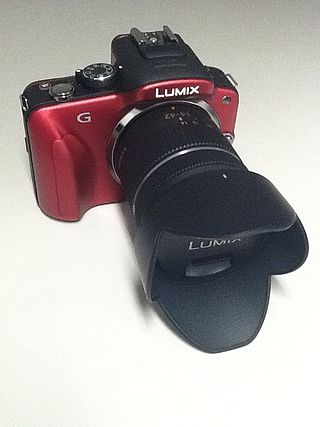
The Panasonic Lumix DMC-G3 is a digital mirrorless interchangeable lens camera adhering to the joint Olympus and Panasonic Micro Four Thirds System (MFT) system design standard. The Panasonic Lumix DMC-G3 is the eighth Panasonic MFT camera introduced under the standard and the thirteenth model MFT camera introduced by either Olympus or Panasonic, as of the G3 product announcement date.

The Panasonic Lumix DMC-G2 is a digital mirrorless interchangeable lens camera that adheres to the Micro Four Thirds System (MFT) design standard developed by Olympus and Panasonic. It was announced by Panasonic in March 2010 along with the Lumix DMC-G10. The G2 was introduced as the successor to the Lumix DMC-G1 camera, with upgrades such as 720p high-definition video recording capability in AVCHD Lite and Motion JPEG formats.
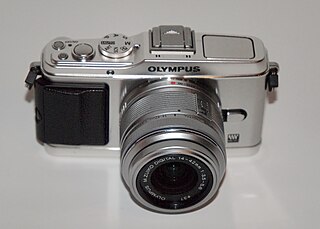
The Olympus PEN E-P3 announced on 30 June 2011 is Olympus Corporation's seventh camera that adheres to the Micro Four Thirds (MFT) system design standard. The E-P3 succeeds the Olympus PEN E-P2, and was announced in concert with two other models, the Olympus PEN E-PL3, and the Olympus PEN E-PM1.

Panasonic Lumix DMC-GF3 is the eighth camera in Panasonic's Lumix G-series adhering to the Micro Four Thirds System (MFT) design standard, and was announced in June 2011.

The Nokia 808 PureView is a Symbian-powered smartphone first unveiled on 27 February 2012 at the Mobile World Congress. It is the first smartphone to feature Nokia's PureView Pro technology, a pixel oversampling technique that reduces an image taken at full resolution into a lower resolution picture, thus achieving higher definition and light sensitivity, and enables lossless digital zoom. It was one of the most advanced camera phones at the time of its release in May 2012.

The Panasonic Lumix DMC-GH3 is a digital mirrorless interchangeable lens camera (MILC) manufactured by Panasonic. It is the successor to the Panasonic Lumix DMC-GH2 and was announced in September 2012 at photokina. It was available from November 2012.

The Panasonic Lumix DMC-GX7 announced in August 2013, is a Micro Four Thirds compact mirrorless interchangeable lens camera. It was Panasonic's first Micro Four Thirds camera with a built-in in-body stabilization system (IBIS) and has a built-in EVF. Panasonic uses 2-axis in-body stabilization allowing the use of shutter speeds 1 to 2 stops slower than without stabilization, compared to the 4 to 5 stops of improvement offered by Olympus' 5-axis stabilization.
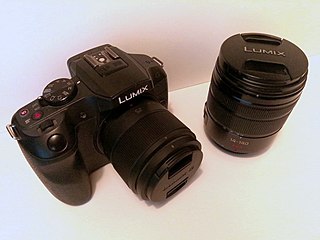
Panasonic Lumix DMC-G6 is a Micro Four Thirds system camera made by Panasonic Lumix. The model was announced in April 2013. The highest-resolution pictures it can record is 16.05 megapixels and the sensor is a Live MOS The camera is not a direct replacement of the Panasonic Lumix DMC-G5, but set in between the G5 and the Panasonic Lumix DMC-GH3.

The Panasonic Lumix DMC-FZ1000 is a digital superzoom bridge camera by Panasonic. It went on sale in June 2014. It has a 20 megapixel 3:2 BSI-CMOS sensor and Leica-branded 25–400 mm equivalent focal length lens with a maximum aperture of f/2.8 to f/4. It has a 1-inch CMOS sensor and supports ISO film speeds from 80 to 25600, shutter speeds from 1/16000 s to 60 s and RAW capture, while the lowest physical shutter speed is 1/4000 s. The unit is equipped with five "Fn" function buttons which can be allocated to custom shortcuts.
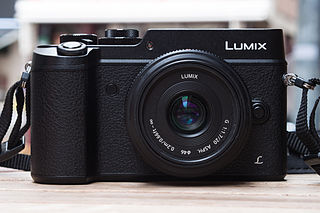
The Panasonic Lumix DMC-GX8 is a digital rangefinder-styled mirrorless interchangeable-lens camera announced by Panasonic on July 16, 2015. The camera features a newly developed 20 megapixel sensor - previously the highest resolution in Micro Four Thirds cameras was 16 megapixels. The camera's ISO range touches 25600 and it can capture continuous frames at up to 8 frames per second. One major new feature introduced in the camera is "Dual IS", the camera 5 axis image stabilisation gets synchronised, when available, with lens based image stabilisation. The camera also records 4K video, but with addition crop around 1.6x.

The Panasonic Lumix DC-GH5S is a Micro Four Thirds mirrorless interchangeable lens camera body announced and released by Panasonic in January 2018.

















